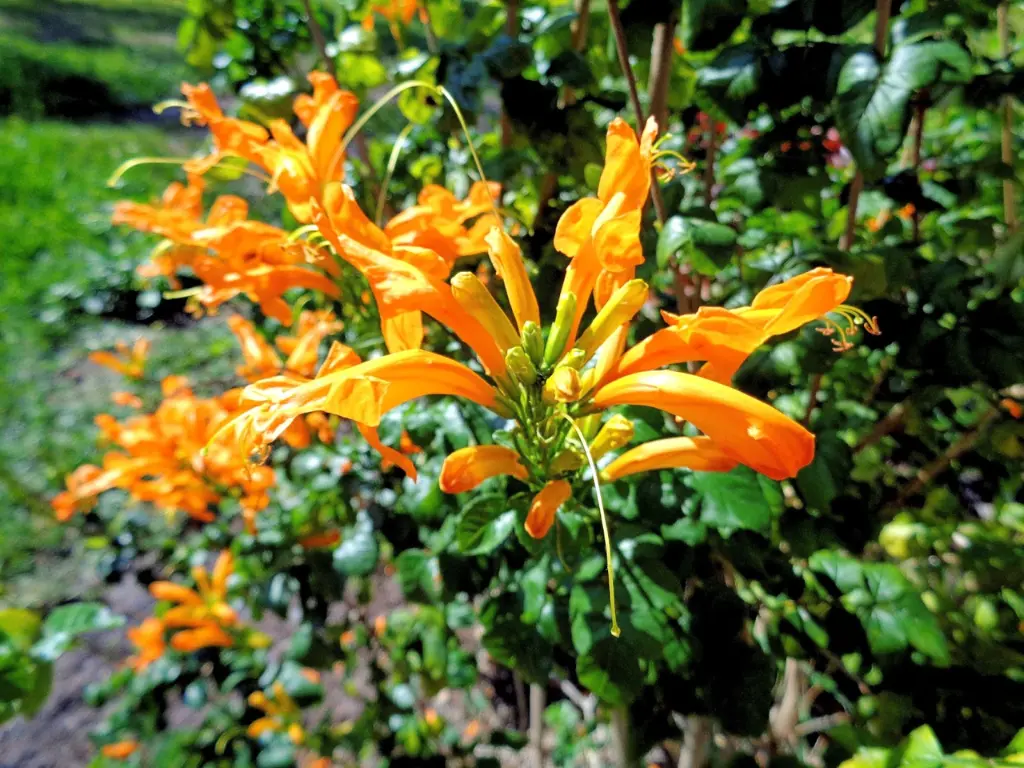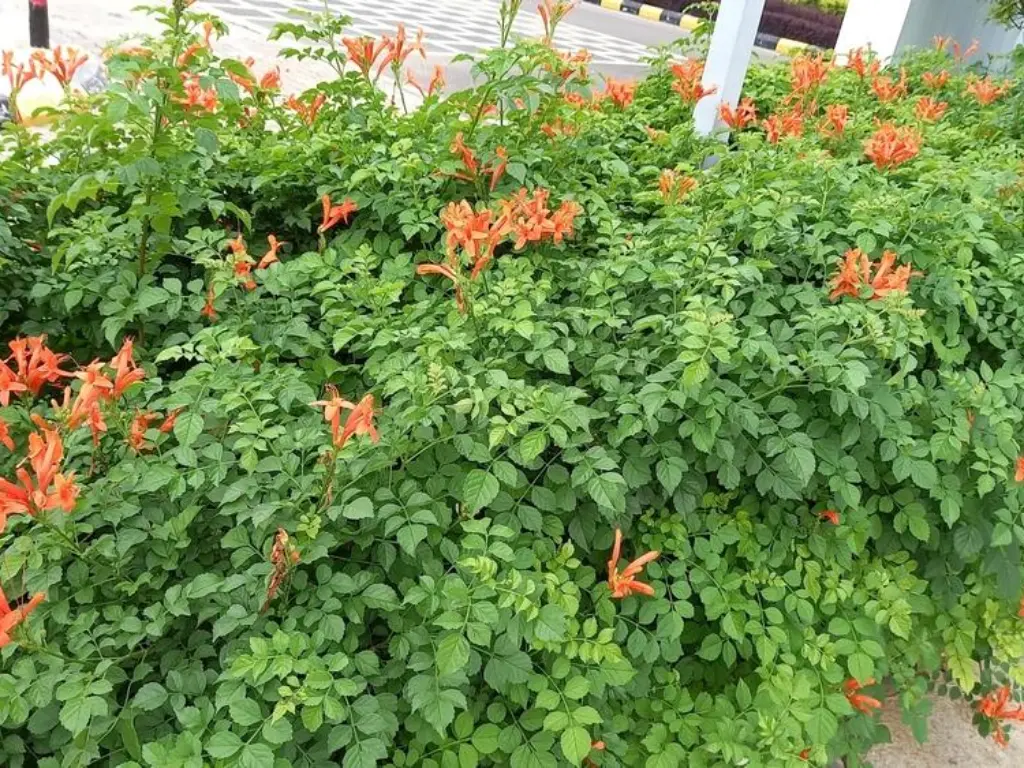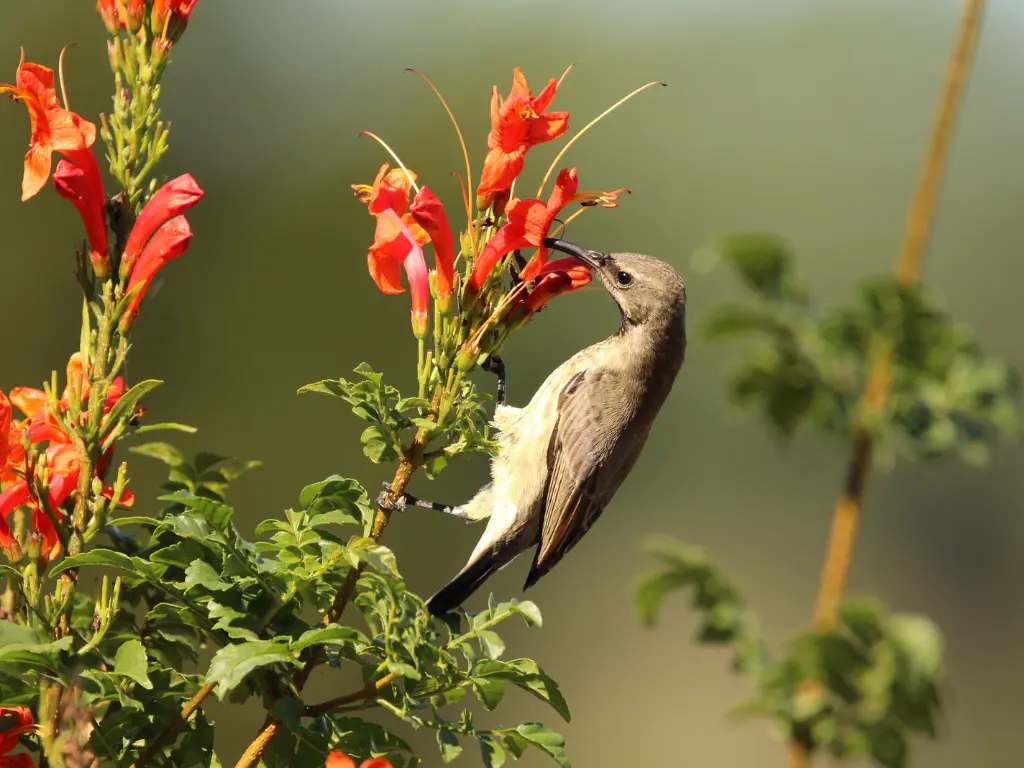Cape honeysuckle is a vigorous evergreen climber known for its vibrant trumpet-shaped blooms and fast growth. Whether you’re aiming for a lush privacy screen, a flowering fence, or a vibrant trellis, this tropical plant can add year-round interest to your garden, especially in USDA zones 9 through 11. This guide will walk you through everything you need to know about Cape Honeysuckle care tips to help your Cape Honeysuckle vine thrive.
What is Cape Honeysuckle?

Cape honeysuckle (Tecoma capensis) is a vibrant, fast-growing evergreen vine or sprawling shrub native to southern Africa. It produces clusters of trumpet-shaped flowers in fiery shades of orange, red, or yellow that bloom from fall through spring. While its flowers aren’t fragrant, they are rich in nectar and highly attractive to hummingbirds, bees, and butterflies.
Cape honeysuckle is prized for its versatility, with a tendency to sprawl unless guided. It can be trained to climb fences, trellises, or pergolas, or left to sprawl as a ground cover or informal hedge. With minimal maintenance and a long blooming season, it’s a favorite among gardeners in USDA zones 9 through 11.
| Attribute | Details |
|---|---|
| Common Name | Cape Honeysuckle |
| Botanical Name | Tecoma capensis |
| Growth Form | Shrub / Vine |
| USDA Zones | 9–11 |
| Bloom Season | Fall – Spring |
| Flower Colors | Orange, Red, Yellow, Apricot |
| Light Requirement | Full sun (6+ hrs) |
| Wildlife | Attracts hummingbirds, bees |
| Drought-Tolerant | Yes, once established |
How to Grow Cape Honeysuckle
Choosing the Right Location
Cape honeysuckle thrives in full sun. For best flowering, select a spot that receives at least six hours of direct sunlight daily. In very hot climates, a bit of afternoon shade can help prevent stress, but too much shade will result in reduced blooms.
Ideal planting locations include:
-
Along fences or walls for vertical training
-
Beside arbors or pergolas
-
In large containers for patios and balconies
Preparing the Soil
This plant is adaptable and will grow in a variety of soil types, from sandy to loamy. The key requirement is good drainage. Although it tolerates both slightly acidic and alkaline soils, enriching the soil with compost or organic matter can improve its vigor and flower production.
If you’re planting in heavy clay, consider amending the area with sand or perlite to enhance drainage.
Planting Cape Honeysuckle
To plant:
-
Dig a hole twice as wide as the root ball and slightly deeper.
-
Place the plant so the top of the root ball is level with the surrounding soil.
-
Backfill with soil and gently firm it in place.
-
Water thoroughly after planting to settle the soil around the roots.
Install a support structure, such as a trellis or fence, immediately after planting if you intend to train it as a Cape honeysuckle vine.
Watering and Fertilizing
Newly planted cape honeysuckle should be watered deeply two to three times per week until established. Once mature, the plant becomes drought-tolerant and can survive on occasional watering.
Fertilizing isn’t always necessary, especially in rich soil. However, if your soil is nutrient-poor, apply a balanced fertilizer (such as 10-10-10) once in late summer to encourage strong blooming in fall and winter.
Cape Honeysuckle Care Tips

Watering
Cape honeysuckle prefers moderate, consistent moisture but does not like wet feet. Allow the soil to dry slightly between waterings. In containers, check frequently, especially in summer, as pots dry out faster than ground soil.
To conserve moisture and reduce weeds, apply a layer of organic mulch around the base of the plant.
Pruning
Pruning serves two purposes: shaping the plant and encouraging new growth. Regular light pruning helps maintain a tidy shape and supports more blooms, especially if the plant is grown as a hedge or climber.
The best time to prune is early spring, after the risk of frost has passed. Remove dead, damaged, or leggy branches. You can also cut back the plant heavily every few years to rejuvenate growth.
Read more: Honeysuckle Vine Pruning Tips You Need to Know
Pest Control
Cape honeysuckle is generally pest-resistant, but it may occasionally attract:
-
Aphids
-
Whiteflies
-
Spider mites
-
Scale insects
Inspect the undersides of leaves regularly. If infestations occur, treat with insecticidal soap or neem oil. Good air circulation and proper watering help prevent most issues.
Common Problems When Growing Cape Honeysuckle
Overwatering and Root Rot
Poor drainage or excessive watering can lead to root rot, which causes leaves to yellow and wilt. To prevent this:
-
Use well-draining soil
-
Avoid watering on a fixed schedule—check soil moisture first
-
Ensure containers have adequate drainage holes
Poor Flowering
If your plant is healthy but not blooming, consider the following factors:
-
Insufficient sunlight
-
Excess nitrogen fertilizer (which promotes leafy growth at the expense of flowers)
-
Pruning too close to the blooming period
Improving light exposure and applying a phosphorus-rich fertilizer can encourage better blooms.
Yellowing Leaves
Yellowing leaves can indicate overwatering, nutrient deficiency, or environmental stress. If only lower leaves are affected, it may be natural aging. However, if new growth is also yellowing, conduct a soil test and adjust care accordingly.
Best Growing Practices for Cape Honeysuckle in Different Environments

Container Growing
Cape honeysuckle grows well in large containers, making it a great option for gardeners in cooler zones or with limited space.
Tips for success:
-
Use a pot at least 12–16 inches wide with drainage holes. Repot every 1–2 years or when roots become crowded. Choose a pot one size larger each time to encourage continued growth.
-
Fill with a quality potting mix
-
Provide a trellis or stake for support
-
Move containers indoors before the first frost and place near a sunny window during winter.
Water container plants more frequently and feed lightly every two to three months during the growing season.
Landscaping Ideas
Cape honeysuckle is highly versatile in the landscape. You can:
-
Train it along fences for privacy and color
-
Grow it as a free-form shrub in a tropical-themed garden
-
Use it as a flowering groundcover (trim vertical shoots to encourage horizontal spread)
-
Combine it with pollinator-friendly plants like salvia or lantana
Its bold colors and vigorous habit make it ideal for focal points or to fill large spaces quickly.
Read more: Lantana Rose Sunrise: The Ultimate Guide to Growing This Vibrant Beauty
How to Propagate Cape Honeysuckle
Cutting Preparation
Cape honeysuckle is easy to propagate from softwood cuttings or suckers. For cuttings:
-
Take a 4–6 inch soft, non-flowering stem in spring or early summer
-
Remove the lower leaves
-
Dip the cut end in rooting hormone for best results
Alternatively, use rooted suckers that naturally emerge near the base of mature plants.
Rooting the Cutting
Plant the prepared cutting in a moist potting mix or a peat-perlite blend. Cover with a plastic bag or humidity dome to maintain moisture. Keep the cutting in indirect sunlight at temperatures between 70–75°F (21–24°C).
Roots usually form in 2 to 3 weeks. Once established, transplant into larger containers or directly into your garden.
Benefits of Growing Cape Honeysuckle

-
Long blooming season (fall to spring)
-
Attracts beneficial wildlife such as hummingbirds, bees, and butterflies
-
Low maintenance once established
-
Versatile use: vine, shrub, groundcover, or container plant
-
Tolerates heat, drought, and poor soil
-
Naturally resistant to deer and most common pests
Cape honeysuckle is an excellent plant for adding tropical charm and ecological value to any garden.
Frequently Asked Questions (FAQ)
Q: Is Cape honeysuckle cold-hardy?
A: Cape honeysuckle is hardy in USDA zones 9–11. In colder zones, it should be grown in containers and brought indoors during winter.
Q: Does cape honeysuckle have a scent?
A: No, the flowers do not have a noticeable fragrance. However, they are rich in nectar and highly attractive to pollinators.
Q: How tall will it grow as a Cape honeysuckle vine?
A: When supported, cape honeysuckle can climb up to 25–30 feet in length. As a shrub, it typically grows 3–10 feet tall and wide.
Q: Is it invasive?
A: In humid regions, especially where there’s plenty of rainfall, cape honeysuckle can spread aggressively through runners and suckers. Regular pruning and maintenance will keep it under control.
Q: Is it safe around pets?
A: Cape honeysuckle is not considered highly toxic, but ingestion by pets should still be avoided. Monitor pets around the plant and consult a vet if ingestion occurs.
Conclusion
Cape honeysuckle vines reward careful placement and consistent care with a brilliant seasonal display and a steady stream of pollinators. With a bit of attention and planning, your garden can enjoy this colorful climber for years to come.
If you’re ready to add a burst of tropical color to your yard or patio, cape honeysuckle is a fantastic place to start.
